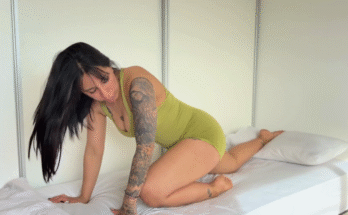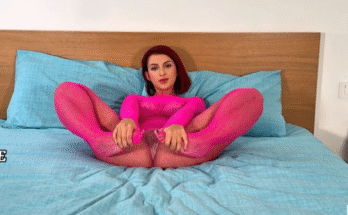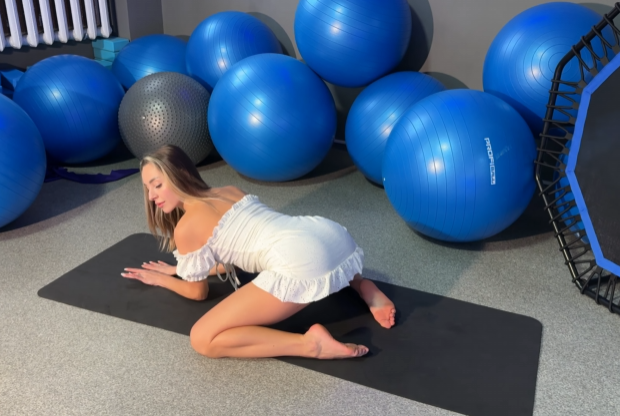
The early morning light streamed gently through the curtains, casting a soft golden glow across the quiet room. The world outside was still waking up, but inside, the space was calm, warm, and peaceful—perfect for a relaxing stretch flow dedicated to back and legs flexibility. It was the kind of morning where the air felt slow and friendly, and the body naturally craved movement, softness, and release.
For many, flexibility training sounds intense—split goals, endless hamstring pulling, or deep backbends. But today’s session was none of that. This was a stretch flow meant to comfort the body, soothe the mind, and gently expand mobility without strain. A practice anyone could join, whether stiff from sitting at a desk or tired after a long week. The intention was simple: to breathe, unwind, and create space.
On the mat, the sequence began with a quiet moment of grounding. Sitting in a comfortable cross-leg position, eyes closed, both hands rested on the knees. Breath guided everything—slow inhales through the nose, and long, steady exhales that signaled the body to soften. With each breath, the spine felt a little taller, the shoulders a little lighter, and the mind a little quieter.
When the body felt ready, the flow eased into gentle head circles, loosening the neck and releasing tension accumulated from sleep or stress. Shoulders rolled forward and back, awakening the upper spine. Nothing fast, nothing forced—just slow, mindful movements melting stiffness away bit by bit.
The first major stretch was a classic forward fold from a seated position. Legs extended long in front, feet flexed, the spine gently lengthened upward before folding forward. Hands slid down the legs, reaching only as far as the body allowed without strain. The stretch awakened the hamstrings and calves, sending a warm, tingling sensation that reminded the practitioner of just how much the legs hold every single day. With every exhale, the body released deeper, as if gravity itself were lending a hand.
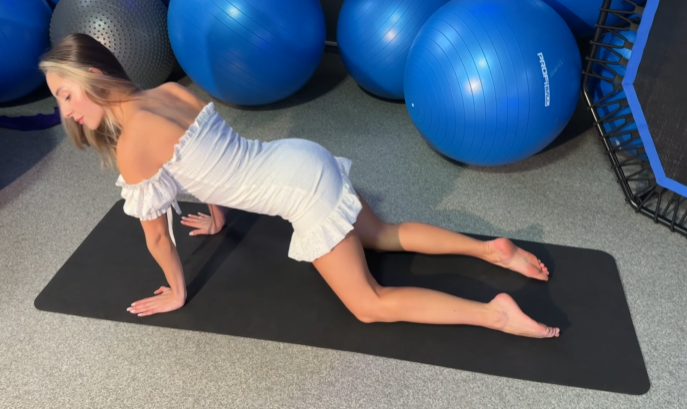
After a minute of breathing into the stretch, the flow transitioned to butterfly pose. The soles of the feet pressed together, knees falling outward like butterfly wings. Hands wrapped around the feet, and the spine gently folded forward. This movement worked wonders on the inner thighs and lower back, a place where tightness often hides silently. The soft stretch felt almost comforting—a reminder that flexibility isn’t just about pushing but about being gently patient with the body.
Once the hips were warmed, it was time for Cat-Cow, the ultimate stretch for the spine. On hands and knees, the back arched upward, then dipped downward, following the rhythm of the breath. Each inhale created space between the vertebrae, and each exhale softened tension stored along the back. The spine felt like it was waking up vertebra by vertebra, allowing energy to flow freely through the body.
From Cat-Cow, the flow naturally shifted into Downward Dog. Feet pressed into the mat, hips lifted high, and the legs stretched long. Heels reached toward the floor—not necessarily touching, but sinking with every breath. A gentle pedaling motion through the feet added movement to the calves, hamstrings, and even the lower back. For many, Downward Dog is a challenge, but in this flow, it was approached like a quiet conversation with the body. No pressure, only awareness.
After waking the legs, the practice eased into a low lunge—one of the best stretches for hip flexors and the psoas, muscles that tighten easily from sitting. With one foot forward and the opposite knee grounded, the hips melted forward, creating a deep but satisfying stretch. Hands could rest on the mat, on blocks, or rise overhead for a deeper back extension. The gentle tug at the front of the thigh felt like freedom returning to the body.
Switching sides brought balance and symmetry. The longer the stretch held, the more the hips began to open, and the more the low back felt relieved. Breath carried the movement, allowing the muscles to soften gradually instead of forcing anything. The stretch was a conversation—not a battle.
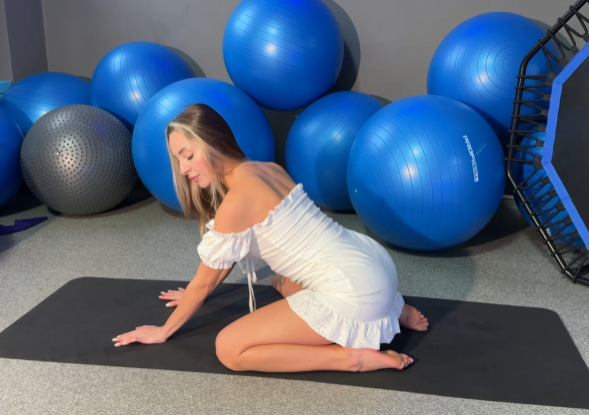
After the lunges, the flow continued into half-splits. From the lunge, hips shifted back, front leg extended, and toes flexed upward. The hamstring lit up with a warm, deep stretch. The upper body leaned forward slowly, following the breath. The goal wasn’t a perfect split; it was simply to lengthen, to encourage flexibility without stress. Many people fear hamstring stretches, but in this relaxing flow, the discomfort was softened by mindful breathing and a gentle approach.
Once both sides felt balanced, the flow brought the body down onto the stomach for a gentle backbend. Cobra pose, with elbows close to the ribs and shoulders sliding down, encouraged the spine to lengthen and the chest to open. It was not a deep bend—not one that strained the lower spine—but rather a subtle lift that awakened the upper back and strengthened the muscles that support posture.
To complement the soft backbend, the next pose was Child’s Pose—a deeply grounding stretch for the entire spine. Knees opened wide, hips sank back to the heels, and arms extended forward. The forehead rested on the mat, offering the nervous system a moment of true rest. The lower back stretched with every breath, and the hips softened. It was a moment of surrender, a pause that reminded the body that stillness can be just as therapeutic as movement.
When the time felt right, the flow lifted back up for seated side stretches. One arm reached overhead while the body folded to the opposite side, lengthening the entire side body—from ribs to hips to outer thighs. These stretches often reveal hidden tightness, especially after a long week of work or stress. Switching sides balanced the torso, leaving the upper body feeling lighter and more open.

The final portion of the practice focused on reclined stretches. Lying on the back, one knee hugged into the chest, releasing the lower spine. A gentle twist followed, creating space along the waist and back. Twists are magical in flexibility training—they realign the spine, relax muscles, and promote circulation. The other side received equal care.
To end the flow, both legs extended up the wall or lifted into the air for a gentle hamstring stretch. The blood flow reversed, calming the nervous system while stretching the back of the legs effortlessly.
Finally, the practice ended in Savasana—legs long, arms relaxed, breath soft. The body absorbed the benefits of the session: loosened muscles, improved flexibility, and a deep sense of calm. The mind settled, and a peaceful warmth spread across the entire body.
This relaxing stretch flow wasn’t about pushing limits or forcing deep flexibility. It was about healing, awareness, and giving the back and legs the care they deserve. With regular practice, the body would naturally grow more flexible—but more importantly, it would grow more relaxed, more open, and more connected to itself.
A gentle reminder echoed silently through the practice:
Flexibility isn’t a goal.
It’s a relationship with your body—one built with patience, breath, and love.

